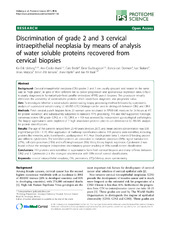| dc.contributor.author | Uleberg, Kai-Erik | en_US |
| dc.contributor.author | Munk, Ane Cecilie | en_US |
| dc.contributor.author | Brede, Cato | en_US |
| dc.contributor.author | Gudlaugsson, Einar | en_US |
| dc.contributor.author | Diermen, Bianca van | en_US |
| dc.contributor.author | Skaland, Ivar | en_US |
| dc.contributor.author | Malpica, Anais | en_US |
| dc.contributor.author | Janssen, Emilius Adrianus Maria | en_US |
| dc.contributor.author | Hjelle, Anne | en_US |
| dc.contributor.author | Baak, Jan P. A. | en_US |
| dc.date.accessioned | 2012-02-06T09:45:56Z | |
| dc.date.available | 2012-02-06T09:45:56Z | |
| dc.date.issued | 2011-06-28 | eng |
| dc.identifier.issn | 1477-5956 | |
| dc.identifier.uri | https://hdl.handle.net/1956/5544 | |
| dc.description.abstract | Background: Cervical intraepithelial neoplasia (CIN) grades 2 and 3 are usually grouped and treated in the same way as “high grade”, in spite of their different risk to cancer progression and spontaneous regression rates. CIN2-3 is usually diagnosed in formaldehyde-fixed paraffin embedded (FFPE) punch biopsies. This procedure virtually eliminates the availability of water-soluble proteins which could have diagnostic and prognostic value. Aim: To investigate whether a water-soluble protein-saving biopsy processing method followed by a proteomic analysis of supernatant samples using LC-MS/MS (LTQ Orbitrap) can be used to distinguish between CIN2 and CIN3. Methods: Fresh cervical punch biopsies from 20 women were incubated in RPMI1640 medium for 24 hours at 4°C for protein extraction and subsequently subjected to standard FFPE processing. P16 and Ki67-supported histologic consensus review CIN grade (CIN2, n = 10, CIN3, n = 10) was assessed by independent gynecological pathologists. The biopsy supernatants were depleted of 7 high abundance proteins prior to uni-dimensional LC-MS/MS analysis for protein identifications. Results: The age of the patients ranged from 25-40 years (median 29.7), and mean protein concentration was 0.81 mg/ml (range 0.55 - 1.14). After application of multistep identification criteria, 114 proteins were identified, including proteins like vimentin, actin, transthyretin, apolipoprotein A-1, Heat Shock protein beta 1, vitamin D binding protein and different cytokeratins. The identified proteins are annotated to metabolic processes (36%), signal transduction (27%), cell cycle processes (15%) and trafficking/transport (9%). Using binary logistic regression, Cytokeratin 2 was found to have the strongest independent discriminatory power resulting in 90% overall correct classification. Conclusions: 114 proteins were identified in supernatants from fresh cervical biopsies and many differed between CIN2 and 3. Cytokeratin 2 is the strongest discriminator with 90% overall correct classifications. | en_US |
| dc.language.iso | eng | eng |
| dc.publisher | BioMed Central | eng |
| dc.rights | Attribution CC BY | eng |
| dc.rights.uri | http://creativecommons.org/licenses/by/2.0/ | eng |
| dc.subject | Cervical intraepithelial neoplasia | eng |
| dc.subject | Proteomics | eng |
| dc.subject | LTQ-Orbitrap | eng |
| dc.subject | Mass spectrometry | eng |
| dc.title | Discrimination of grade 2 and 3 cervical intraepithelial neoplasia by means of analysis of water soluble proteins recovered from cervical biopsies | en_US |
| dc.type | Peer reviewed | |
| dc.type | Journal article | |
| dc.description.version | publishedVersion | en_US |
| dc.rights.holder | Copyright 2011 Uleberg et al; licensee BioMed Central Ltd. | |
| dc.source.articlenumber | 36 | |
| dc.identifier.doi | https://doi.org/10.1186/1477-5956-9-36 | |
| dc.source.journal | Proteome Science | |
| dc.source.40 | 9 | |
| dc.subject.nsi | VDP::Medical disciplines: 700::Clinical medical disciplines: 750::Oncology: 762 | eng |

